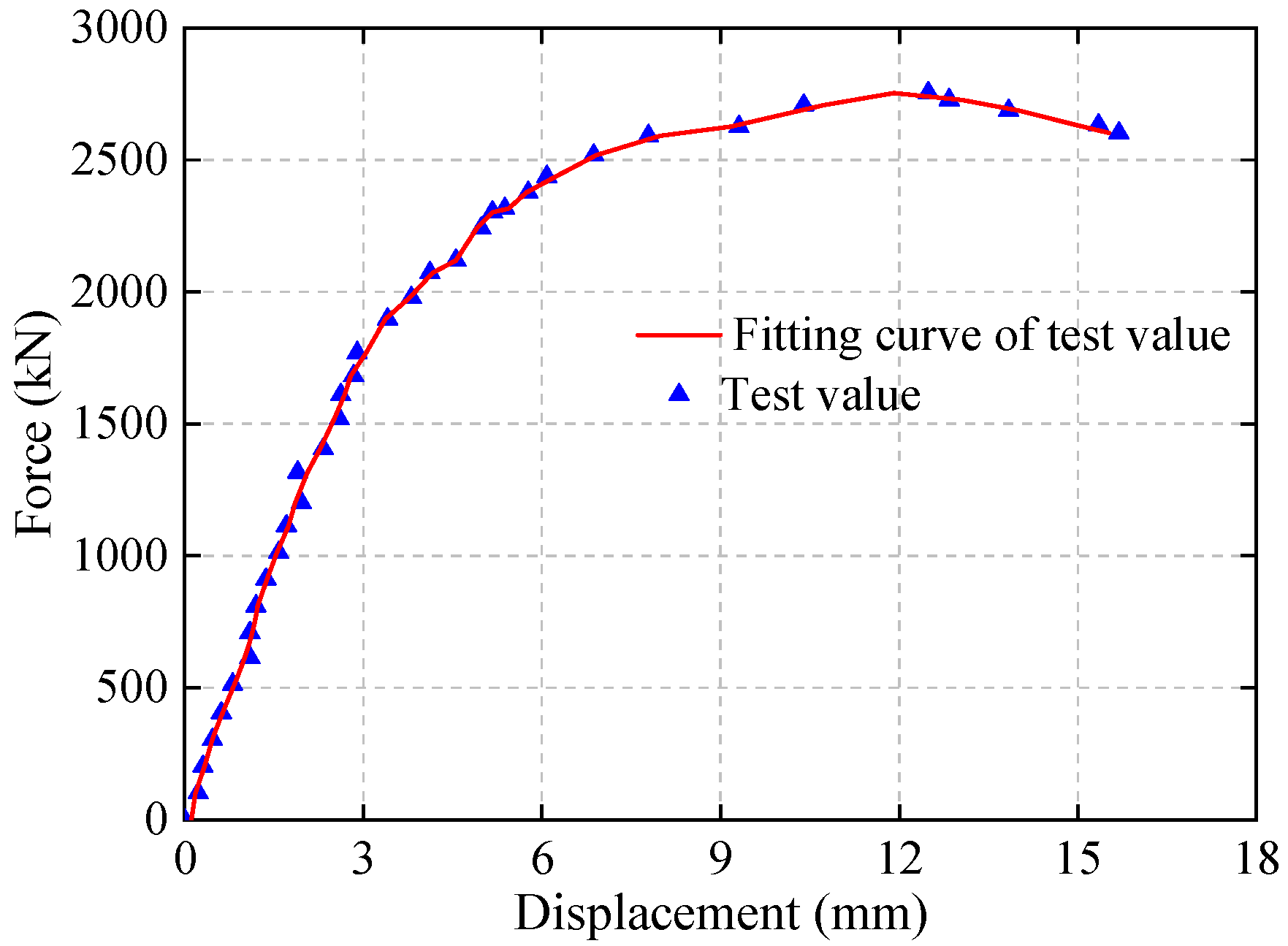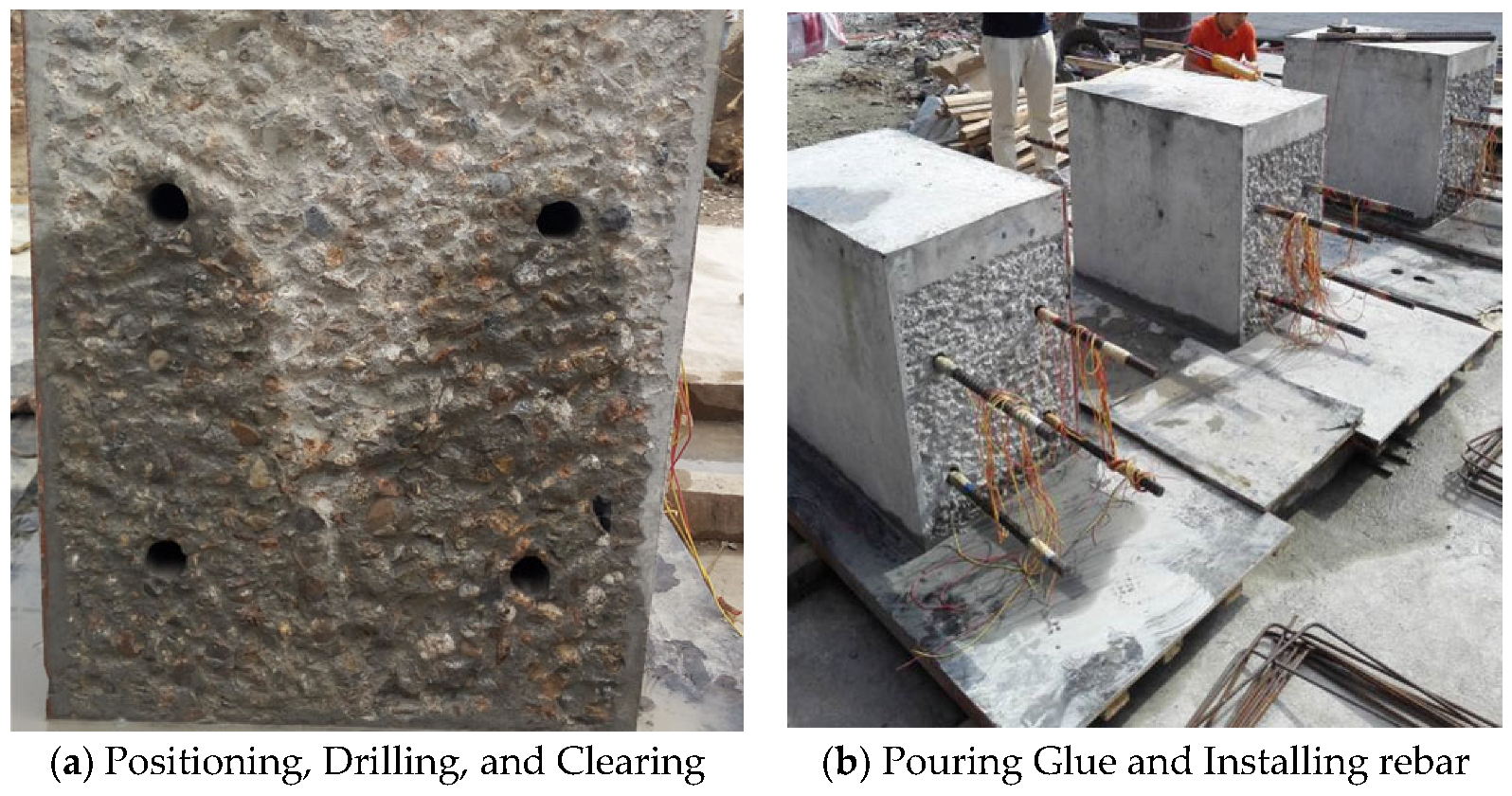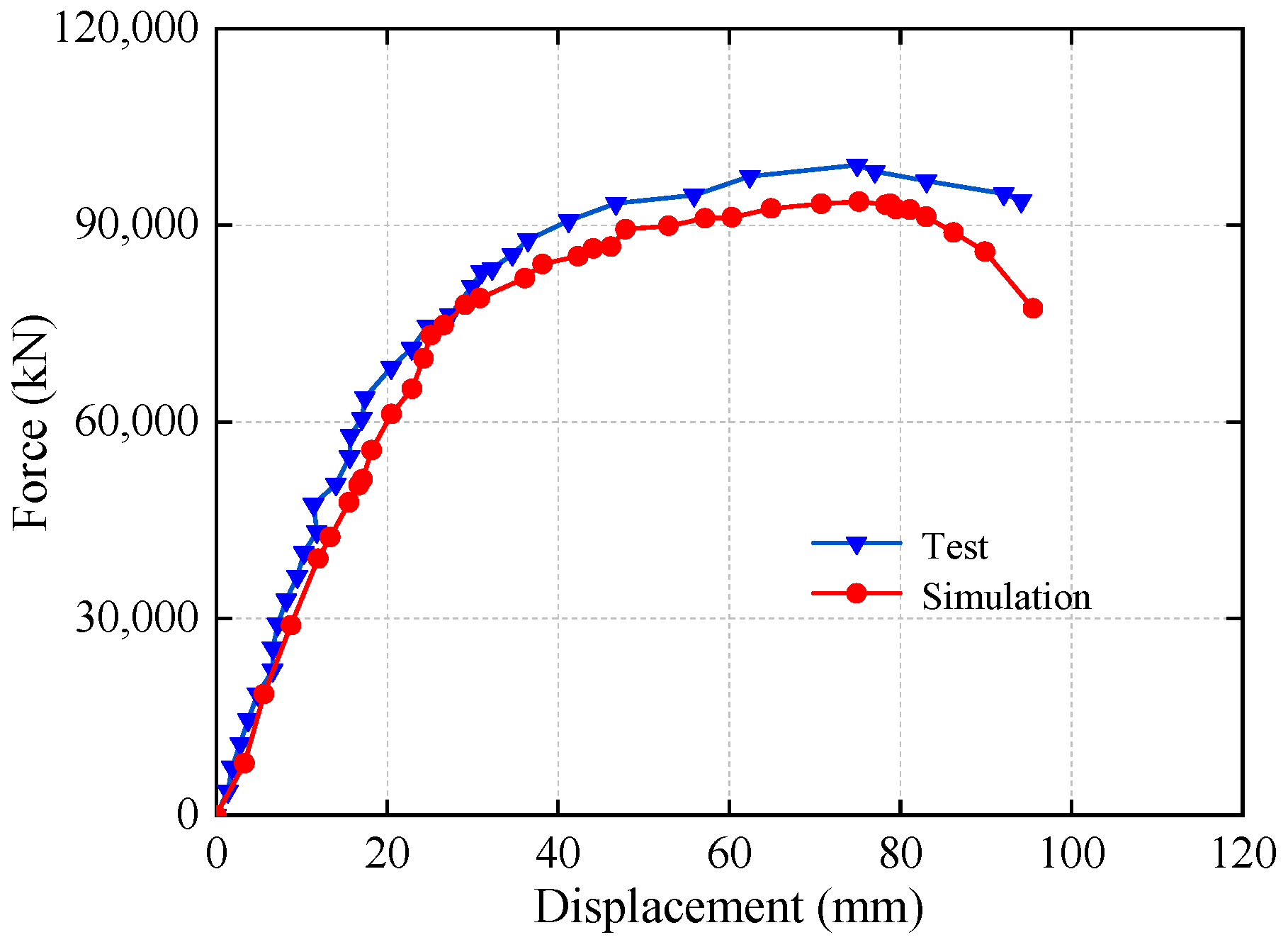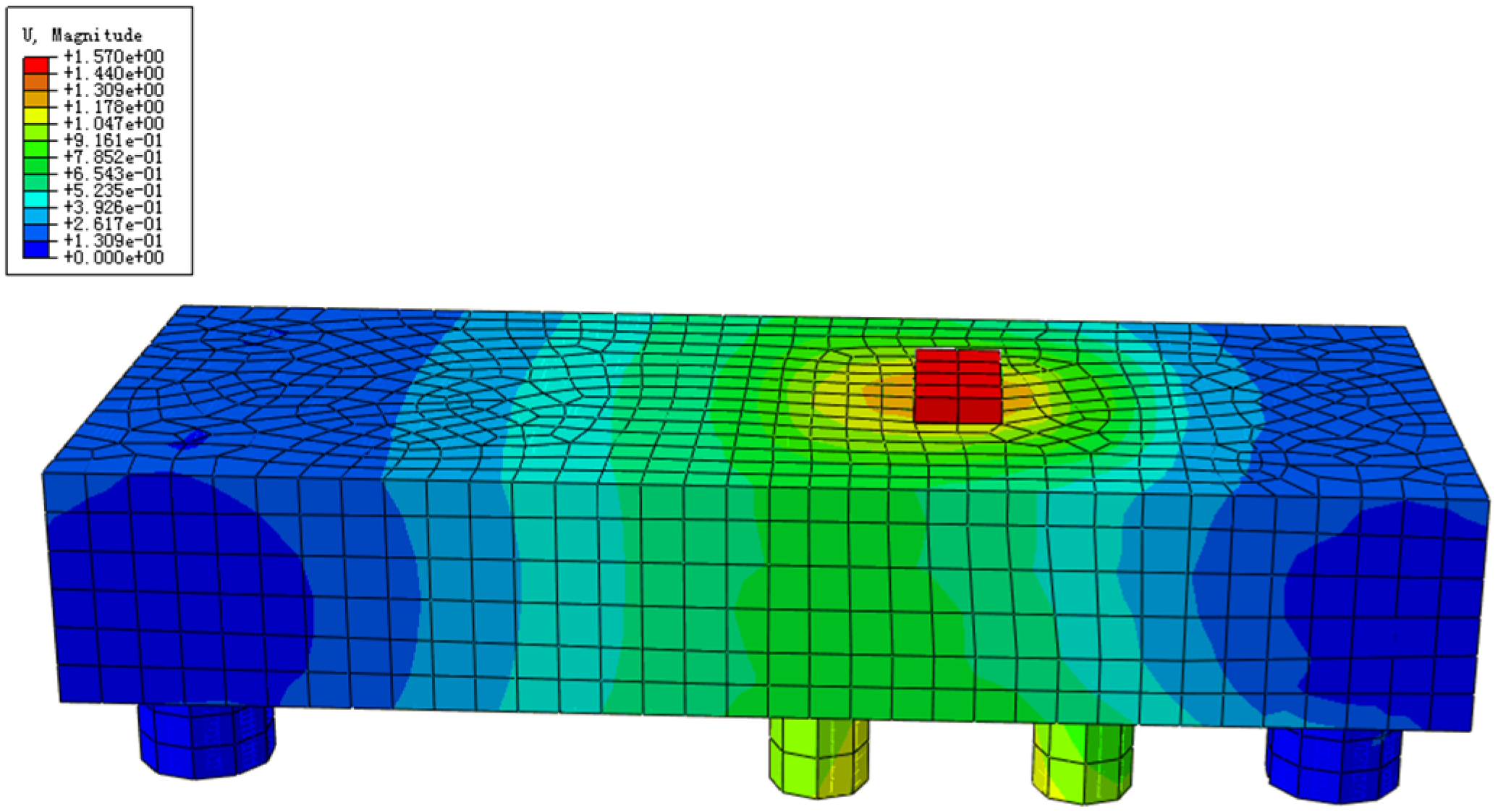Experimental and Numerical Investigation on Pile Foundation Underpinning Structure System in Urban Overpass
Abstract
1. Introduction
2. Design of the Testing
2.1. Similarity Relation
2.2. Model Design and Construction
2.3. Model Materials
2.4. Test Setup and Measuring Point
3. Test Results
3.1. Experimental Phenomenon
3.2. Specimen Load Capacity

3.3. Specimen Load Capacity
4. Finite Element Simulation Analysis
4.1. Model
4.2. Comparison of Test and Finite Element Computation Results
4.3. Displacement
4.4. Underpinning Beam Structures Concrete Stress Analysis
4.5. Stress Analysis of Reinforcement in Underpinning Structure
5. Conclusions
- The damage condition of the pile foundation underpinning was slight under the test load, and there was no localized damage or general bending and shear damage, indicating the safety of “joints with rough interface + planting reinforcement + prestressing + epoxy resin reinforcing adhesive of planting rebar connection”.
- The specimen deformation is small in the early loading stage, and the displacement curves of different measurement points are more coordinated, indicating that the combined surface of old and new concrete inside the underpinning beam body is still reliable. However, once the specimen enters the yielding stage, the deformation of the bearing platform section clearly shows an uncoordinated phenomenon, which indicates that the section of the beam is more concentrated in the force and that it is a weak region for the whole pile foundation beam structure system, and it should be noticed during the design.
- The displacement cloud, reinforcement stress cloud, and concrete stress cloud of the pile foundation underpinning beam structure system show that the underpinning structure is in the elastic stage under the construction load, and even under the ultimate load, the underpinning beam structure does not show any overall damage, which indicates that the underpinning beam safety reserve is large enough.
- The finite element simulation analysis of the overall model of the pile foundation beam structure shows that test results and simulation results are in great agreement, which verifies the accuracy of the modeling method and the test results. The finite element analysis results can be used as a supplement to the test, and then the detailed force conditions in the pile foundation beam structure system can be analyzed to guide the smooth implementation of the actual project.
Author Contributions
Funding
Institutional Review Board Statement
Informed Consent Statement
Data Availability Statement
Conflicts of Interest
References
- Masuda, Y.; Minoshima, T.; Makino, H. Large-scale underpinning for an underground urban railway station. Tunn. Undergr. Space Technol. 1992, 7, 133–140. [Google Scholar] [CrossRef]
- Jing, D.; Cao, S.; Guo, H. Application of steel plate-masonry composite structure technology for underpinning of masonry walls. China Civ. Eng. J. 2009, 42, 55–60. [Google Scholar]
- Robison, M.S. Excavation Support and Micropile Underpinning in Vail, Colorado. In Proceedings of the Biennial Geotechnical Seminar, Denver, CO, USA, 5 November 2010; pp. 112–118. [Google Scholar]
- Onuki, T.; Gima, K.; Matsuoka, M. Design and Construction Planning for the Keage Underground Station on the Kyoto Tozai Line. J. Tunn. Eng. JSCE 2011, 1, 281–286. [Google Scholar]
- Luo, H.C. Research on Initiative Underpinning Technology of Light Rail Bridge Columns under the Dynamic Load. Master’s Thesis, Hebei University of Technology, Tianjin, China, 2014. [Google Scholar]
- Gou, J.H.; Zhang, S.Z.; Ke, Z.T.; Deng, A.X.; Sun, N. Model Test of Beam-Column Joint for Pile Foundation Underpinning under Large Axial Force. China Civ. Eng. J. 2004, 37, 62–68+91. [Google Scholar]
- Yang, X.J.; Deng, F.H.; Wu, J.J. Response of carrying capacity of piles induced by adjacent Metro tunneling. Min. Sci. Technol. 2009, 19, 176–181. [Google Scholar] [CrossRef]
- Xu, D. Case Study on Design of Underpinning of Foundation Piles of Yiguanmiao Overpass in Construction of Line 3 of Chengdu Metro. Tunn. Constr. 2015, 35, 821–827. [Google Scholar]
- Ma, W.J.; Wang, X.; Wang, B.L.; Wang, B.L.; Wang, X.L. Application of Passive Pile Foundation Underpinning Technology on Lanzhou Rail Transit Line 1. Urban Mass Transit 2020, 23, 51–55. [Google Scholar] [CrossRef]
- Wang, S.Z.; Duan, S.J.; Cao, J.P. Structural dynamic analysis of under pinning piles. J. Shijiazhuang Railw. Inst. (Nat. Sci.) 2009, 22, 53–56. [Google Scholar]
- Bi, J.D. Study on Pile Foundation Underpinning Techniques in Subway Construction. Master’s Thesis, Shijiazhuang Railway University, Shijiazhuang, China, 2007. [Google Scholar]
- Yu, J.C. Numerical Analysis for Technology of Underpinning Structure Composed of Piles and Beams. Master’s Thesis, Shandong Jianzhu University, Jinan, China, 2013. [Google Scholar]
- Shan, H.F.; Yu, F.; Xia, T.D.; Lin, C.G.; Pan, J.L. Performance of the underpinning piles for basement-supplementing retrofit of a constructed building. J. Perform. Constr. Facil. 2017, 31, 401–407. [Google Scholar] [CrossRef]
- Xu, Q.W.; Zhu, H.H.; Ma, X.F.; Ma, Z.Z.; Li, X.J.; Tang, Z.H.; Zhuo, K. Pie underpinning and removing technology of shield tunnels crossing through group pile foundations of road bridges L1. Chin. J. Geotech. Eng. 2012, 34, 1217–1226. [Google Scholar]
- Xu, Q.; Zhu, H.; Ma, X.; Ma, Z.; Li, X.; Tang, Z. A case history of shield tunnel crossing through group pile foundation of a road bridge with pile underpinning technologies in Shanghai. Tunn. Undergr. Space Technol. 2015, 45, 20–33. [Google Scholar] [CrossRef]
- Li, Z.; Chen, Z.Q.; Wang, L.; Zeng, Z.K.; Gu, D.M. Numerical simulation and analysis of the pile underpinning technology used in shield tunnel crossings on bridge pile foundations. Undergr. Space 2021, 6, 396–408. [Google Scholar] [CrossRef]
- Li, D.C.; Qian, J.G.; Wu, S.M.; Liu, G.Y. Numerical analysis of deformation behaviors of underpinning piles during excavation. Chin. J. Geotech. Eng. 2012, 34, 238–242. [Google Scholar]
- Dong, J.Y.; Liu, Z.S.; Wang, G.H.; Li, P.; Liu, Z.D. Application of Self-balance Experimental Method on Pile Bearing Capacity in a Pile Foundation Engineering. J. North China Univ. Water Resour. Electr. Power (Nat. Sci. Ed.) 2015, 36, 55–60. [Google Scholar]
- Wang, X.P. Experimental Study on Bridge Pile Foundation Underpinning Technology of Subway Tunnel Crossing Loess Area. Railw. Eng. 2021, 61, 27–30. [Google Scholar]
- Huang, C.X.; Yuan, W.X.; Hu, G.J. An estimation method of horizontal bearing capacity of piles after pre-consolidation treatment for layered soft foundation. Rock Soil Mech. 2021, 42, 113–124+134. [Google Scholar] [CrossRef]
- Huang, X.; Cheng, X.; Yan, Q.X.; Song, L.Y.; Yang, T. Research of Pile Foundation Mechanics Behavior and Parameters Underpinning of Subway Running Tunnel Passing Under the Existing Bridge. Constr. Technol. 2017, 46, 67–70+85. [Google Scholar]
- Zhang, X.; Jia, L.D.; Xia, F.M.; Wang, H.; Tan, T.L.; Si, D.L. Experimental study on the mechanical performance of frame column underpinning nodes. J. Build. Struct. 2011, 32, 89–96. [Google Scholar]
- Zhang, C.R.; Zhao, Y.J.; Zhang, Z.; Zhu, B. Case Study of Underground Shield Tunnels in Interchange Piles Foundation Underpinning Construction. Appl. Sci. 2021, 11, 1611. [Google Scholar] [CrossRef]
- Yue, Q.X.; Ren, X.D.; Zhang, X. Mechanical properties of underpinning joints in structural moving: Experiments and numerical modeling. Struct. Des. Tall Spec. Build. 2017, 26, 1379–1382. [Google Scholar] [CrossRef]
- Yan, L.; Wang, G.; Chen, M.; Yue, K.; Li, Q. Experimental and application study on underpinning engineering of bridge pile foundation. Adv. Civ. Eng. 2018, 2018, 5758325. [Google Scholar] [CrossRef]
- Horpibulsuk, S.; Kumpala, A.; Katkan, W. A Case History on Underpinning for a Distressed Building on Hard Residual Soil Underneath Non-Uniform Loose Sand. Soils Found. 2008, 48, 267–285. [Google Scholar] [CrossRef][Green Version]
- Wang, B.; Zhang, B.Y. Study on underpinning of pile foundation of existing bridge during metro tunnel driving. Railw. Eng. 2011, 4, 47–48. [Google Scholar]
- Kou, W. Application of Active Underpinning Technique in Construction of Zhengzhou Metro Shield Tunnel Passing under Bridge Pile Foundation. Railway 2018, 58, 87–90. [Google Scholar]
- Tu, Y.Z.; Chen, T. Research and Application of Underpinning Technology of Pile Foundation by Longitudinal Wall-Beam in Mined Tunnel. Tunn. Constr. 2021, 41, 398–407. [Google Scholar]
- Igba, U.T.; Igba, P.O.; Adekunle, A.A.; Labiran, J.O.; Oyebisi, S.O.; Cosmas, C.A. Strengthening and underpinning of a sinking two story building in Lagos State Nigeria. Eng. Fail. Anal. 2023, 150, 107334. [Google Scholar] [CrossRef]
- Ritvars, B.; Remo, M.; Janis, Z. Research of Potential Catalysts for Two-Component Silyl-Terminated Prepolymer/Epoxy Resin Adhesives. Polymers 2023, 15, 2269. [Google Scholar]
- Ba, H.; Guo, L.; Huan, H.; Zhang, S.; Lin, Z. Multi-Objective Optimization of Epoxy Resin Adhesive for Pavement Toughened by Self-Made Toughening Agent. Polymers 2023, 15, 1946. [Google Scholar] [CrossRef] [PubMed]
- Cai, W.; Yuan, Z.G.; Wang, Z.C.; Guo, Z.Y.; Zhang, L.L.; Wang, J.; Liu, W.T. Enhancing the toughness of epoxy resin by using a novel hyperbranched benzoxazine. React. Funct. Polym. 2021, 164, 104920. [Google Scholar] [CrossRef]
- Lee, M.K.; Kwon, W.; Kwon, D.; Lee, E.; Jeong, E. Fracture toughness of the novel in-situ polytriazolesulfone modified epoxy resin for carbon fiber/epoxy composites. J. Ind. Eng. Chem. 2019, 77, 461–469. [Google Scholar] [CrossRef]
- Yun-Ji, L.; Soo-Jin, P. Fracture toughness and ductile characteristics of epoxy resin modified with biodegradable polymer. Korea Polym. Soc. 2017, 42, 120. [Google Scholar]
- De Maio, U.; Gaetano, D.; Greco, F.; Lonetti, P.; Nevone Blasi, P.; Pranno, A. The Reinforcing Effect of Nano-Modified Epoxy Resin on the Failure Behavior of FRP-Plated RC Structures. Buildings 2023, 13, 1139. [Google Scholar] [CrossRef]
- Wang, S.; Cao, M.; Xue, H.; Cong, F.; Li, X.; Zhao, C.; Su, W. Nano-silica reinforced epoxy resin/nano-rubber composite material with a balance of stiffness and toughness. High Perform. Polym. 2021, 33, 685–694. [Google Scholar] [CrossRef]
- Albahkali, T.; Fouly, A.; Alnaser, I.A.; Elsheniti, M.B.; Rezk, A.; Abdo, H.S. Investigation of the Mechanical and Tribological Behavior of Epoxy-Based Hybrid Composite. Polymers 2023, 15, 3880. [Google Scholar] [CrossRef]
- Michałowska-Maziejuk, D.; Goszczyńska, B. Effectiveness of Strengthening RC Beams Using Composite Materials—An Accelerated Strengthening Method. Materials 2023, 16, 4847. [Google Scholar] [CrossRef]
- Liu, M.M.; Zhang, L.; Lee, C. New Epoxy with Self-Repairing Properties of Environmental-Friendly Building Structure Adhesives. Ecol. Chem. Eng. S 2021, 28, 39–48. [Google Scholar] [CrossRef]
- He, X.G. Application of New-type Epoxy Resin Mortar in Planting Reinforcement Bar of Highway Engineering. J. Railw. Eng. Soc. 2012, 29, 62–66. [Google Scholar]















| Type | Physical Quantities | Similarity Relation | Similar Constants |
|---|---|---|---|
| Material performance | Stress | Sσ | 1 |
| Strain | Sε | 1 | |
| Elastic modulus | Sσ | 1 | |
| Poisson’s ratio | 1 | 1 | |
| Geometrical performance | Geometrical size | Sl | 1/6 |
| Linear displacement | Sl | 1/6 | |
| Angular displacement | 1 | 1 | |
| Force | concentrated loads | Sl2 | 1/36 |
| Items | Prototype (cm) | Model (cm) | |
|---|---|---|---|
| Piers | Length | 250 | 41.67 |
| Width | 130 | 21.67 | |
| Abutment | Length | 650 | 108.33 |
| Width | 650 | 108.33 | |
| Height | 200 | 33.33 | |
| Underpinning beam | Length | 2030 | 338 |
| Width | 870 | 145 | |
| Height | 350 | 58.33 | |
| Type | Physical Quantities | Yield Strength (Mpa) | Ultimate Tensile Strength (Mpa) | Extensibility |
|---|---|---|---|---|
| Reinforcement | Major reinforcement of the underpinning beam | 396.33 | 548.33 | 6.5 |
| Other bars | 346 | 463 | 6.1 | |
| Prestressed tendons | -- | 1877 | 1.75 | |
| Concrete | Underpinning beam (The second pouring) | 53.41 | ||
| Thermal Distortion Temperature (°C) | Fracture Elongation (%) | Thermal Expansion Coefficient (10−5 m/(m·°C) | Tensile Strength (Mpa) | Compressive Strength (Mpa) | |
|---|---|---|---|---|---|
| Epoxy | 46–288 | 3–6 | 4.5–6.5 | 28–91 | 105–175 |
| Preloading | Loading | ||
|---|---|---|---|
| Loading protocol | 0–100 kN | 100 kN–1900 kN | 1900 kN–2700 kN |
| Loop loading twice | Loading step with 150 kN | Loading step with 100 kN | |
| loading level | L0 | L0–L12 | L12–L20 |
Disclaimer/Publisher’s Note: The statements, opinions and data contained in all publications are solely those of the individual author(s) and contributor(s) and not of MDPI and/or the editor(s). MDPI and/or the editor(s) disclaim responsibility for any injury to people or property resulting from any ideas, methods, instructions or products referred to in the content. |
© 2023 by the authors. Licensee MDPI, Basel, Switzerland. This article is an open access article distributed under the terms and conditions of the Creative Commons Attribution (CC BY) license (https://creativecommons.org/licenses/by/4.0/).
Share and Cite
Yan, L.; Gou, X.; Guo, Z.; Zhang, X.; Jiang, Y.; Ran, X.; Chen, G.; Yue, K. Experimental and Numerical Investigation on Pile Foundation Underpinning Structure System in Urban Overpass. Materials 2023, 16, 6576. https://doi.org/10.3390/ma16196576
Yan L, Gou X, Guo Z, Zhang X, Jiang Y, Ran X, Chen G, Yue K. Experimental and Numerical Investigation on Pile Foundation Underpinning Structure System in Urban Overpass. Materials. 2023; 16(19):6576. https://doi.org/10.3390/ma16196576
Chicago/Turabian StyleYan, Lei, Xiaoying Gou, Zhengchao Guo, Xin Zhang, Yu Jiang, Xingwen Ran, Guanwen Chen, and Kefeng Yue. 2023. "Experimental and Numerical Investigation on Pile Foundation Underpinning Structure System in Urban Overpass" Materials 16, no. 19: 6576. https://doi.org/10.3390/ma16196576
APA StyleYan, L., Gou, X., Guo, Z., Zhang, X., Jiang, Y., Ran, X., Chen, G., & Yue, K. (2023). Experimental and Numerical Investigation on Pile Foundation Underpinning Structure System in Urban Overpass. Materials, 16(19), 6576. https://doi.org/10.3390/ma16196576






